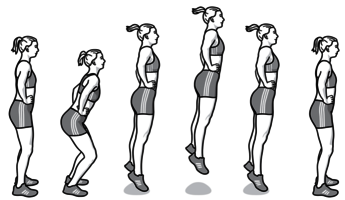

Countermovement Jump
Die Sende- und Empfängereinheit des Optojump Systems werden mit einem Abstand von 1 m parallel zu einer auf ebenem und festen Boden platziert. Die Ausgangsposition des Athleten ist der aufrechte Stand zwischen den Einheiten. Die Hände bleiben während der gesamten Bewegung an den Hüften. Der Athlet soll beide Beine bis zu einer selbstgewählten Tiefe beugen und sie dann sofort so schnell wie möglich strecken, um so hoch wie möglich abzuspringen. Jeder Athlet hat insgesamt drei Versuche und 30 Sekunden Pause zwischen den Versuchen.
Hinweis
Testleiterhinweise
Ziel
Bestimmung der maximalen Sprunghöhe als Maß für die willkürliche Schnellkraftfähigkeit der Hüft-, Knie- und Sprunggelenksstreckmuskulatur.
Organisation
Material
- 1 Optojump-System (Master)
- PC inkl. OptojumpNext Software
- Stoppuhr
Athletenanweisung
"Gehe aus dem Stand in die Knie und springe dann sofort so hoch wie möglich vom Boden ab. Lass dabei die ganze Zeit die Hände an den Hüften."
Datenerfassung
Fehlversuche
- Hände verlassen Hüfte
- Hüfte oder Knie in Flugphase gebeugt
- Landung außerhalb des Optojump-Systems
Orientierungswerte
Gütekriterien
Reliabilität
Eine Übersicht der relativen Reliabilität der Sprunghöhe beim Countermovement Jump ohne Armeinsatz unter Verwendung des OptoJump-Systems ist in der folgenden Tabelle dargestellt. Demnach ist das Niveau der Reliabilität als moderat bis exzellent anzunehmen (10). Insgesamt fünf der sechs dargestellten Untersuchungen haben die Kurzzeit-Reliabilität bei zwei bis drei Sprüngen mit ein bis zwei Minuten Pause am selben Tag bei Kampfsportlern auf mindestens nationalem Wettkampfniveau berichtet (2, 6, 17–19). Nur eine der dargestellten Untersuchungen hat die Test-Retest-Reliabilität über einen längeren Zeitraum von einer Woche untersucht, allerdings nicht mit Athleten (8). Aus den Angaben zum SEM ergibt sich eine minimal feststellbare Veränderung von 2,6 cm
| Sportart | Anzahl w/m | ICC (95% KI) | SEM | %CV | Referenz |
|---|---|---|---|---|---|
| Fechten | 0/54 | 0,82 (0,68 - 0,90) | n.a. | n.a. | Di Cagno et al. (2020) |
| Fechten | 21/49 | 0,96 | n.a. | n.a. | Turner et al. (2016) |
| Fechten | 0/9 | 0,95 (0,92 - 0,96) | n.a. | 2,9 % | Turner et al. (2017) |
| Taekwondo | 4/11 | 0,93 | n.a. | n.a. | Chiodo et al. (2011) |
| Takewondo | 0/14 | 0,93 | 0,95 cm | n.a. | Yousfi et al. (2018) |
| Nicht-Athleten | 10/10 | 0,99 (0,97 - 1,00) | n.a. | 2,2 % | Glattgorn et al. (2011) |
ICC: Intraklassenkorrelationskoeffizient, KI: Konfidenzintervall, SEM: Standardfehler des Mittelwertes, CV: Variationskoeffizient.
- Chaabene H, Negra Y, Capranica L, Bouguezzi R, Hachana Y, Rouahi MA, Mkaouer B. Validity and Reliability of a New Test of Planned Agility in Elite Taekwondo Athletes. J Strength Cond Res. 2018; 32: 2542–2547. doi:10.1519/JSC.0000000000002325.
- Chiodo S, Tessitore A, Cortis C, Lupo C, Ammendolia A, Iona T, Capranica L. Effects of official Taekwondo competitions on all-out performances of elite athletes. J Strength Cond Res. 2011; 25: 334–339. doi:10.1519/JSC.0b013e3182027288.
- Chiodo S, Tessitore A, Lupo C, Ammendolia A, Cortis C, Capranica L. Effects of official youth taekwondo competitions on jump and strength performance. Eur J Sport Sci. 2012; 12: S. 113-120. doi:10.1080/17461391.2010.545837.
- Chtara H, Negra Y, Chaabene H, Chtara M, Cronin J, Chaouachi A. Validity and Reliability of a New Test of Change of Direction in Fencing Athletes. Int J Environ Res Public Health. 2020; 17. doi:10.3390/ijerph17124545.
- Daaloul H, Souissi N, Davenne D. Effects of Napping on Alertness, Cognitive, and Physical Outcomes of Karate Athletes. Med Sci Sports Exerc. 2019; 51: 338–345. doi:10.1249/MSS.0000000000001786.
- Di Cagno A, Iuliano E, Buonsenso A, Giombini A, Di Martino G, Parisi A, Calcagno G, Fiorilli G. Effects of Accentuated Eccentric Training vs Plyometric Training on Performance of Young Elite Fencers. J Sports Sci Med. 2020; 19: 703–713.
- Dunn EC, Humberstone CE, Franchini E, Iredale KF, Blazevich AJ. Relationships Between Punch Impact Force and Upper- and Lower-Body Muscular Strength and Power in Highly Trained Amateur Boxers. J Strength Cond Res. 2020. doi:10.1519/JSC.0000000000003585.
- Glatthorn JF, Gouge S, Nussbaumer S, Stauffacher S, Impellizzeri FM, Maffiuletti NA. Validity and reliability of Optojump photoelectric cells for estimating vertical jump height. J Strength Cond Res. 2011; 25: 556–560. doi:10.1519/JSC.0b013e3181ccb18d.
- Kontochristopoulos N, Bogdanis GC, Paradisis G, Tsolakis C. Effect of a Supplementary Periodized Complex Strength Training and Tapering Period on Postactivation Potentiation of Sport-Specific Explosive Performance in Adolescent National-Level Fencers. J Strength Cond Res. 2019. doi:10.1519/JSC.0000000000002967.
- Koo TK, Li MY. A Guideline of Selecting and Reporting Intraclass Correlation Coefficients for Reliability Research. J Chiropr Med. 2016; 15: 155–163. doi:10.1016/j.jcm.2016.02.012.
- Loturco I, Nakamura FY, Artioli GG, Kobal R, Kitamura K, Cal Abad CC, Cruz IF, Romano F, Pereira LA, Franchini E. Strength and Power Qualities Are Highly Associated With Punching Impact in Elite Amateur Boxers. J Strength Cond Res. 2016; 30: 109–116. doi:10.1519/JSC.0000000000001075.
- Norjali Wazir, Mohd Rozilee Wazir, van Hiel M, Mostaert M, Deconinck FJA, Pion J, Lenoir M. Identification of elite performance characteristics in a small sample of taekwondo athletes. PLoS One. 2019; 14: e0217358. doi:10.1371/journal.pone.0217358.
- San Juan AF, López-Samanes Á, Jodra P, Valenzuela PL, Rueda J, Veiga-Herreros P, Pérez-López A, Domínguez R. Caffeine Supplementation Improves Anaerobic Performance and Neuromuscular Efficiency and Fatigue in Olympic-Level Boxers. Nutrients. 2019; 11. doi:10.3390/nu11092120.
- Slimani M, Taylor L, Baker JS, Elleuch A, Ayedi FM, Chamari K, Chéour F. Effects of mental training on muscular force, hormonal and physiological changes in kickboxers. J Sports Med Phys Fitness. 2017; 57: 1069–1079. doi:10.23736/S0022-4707.16.06421-5.
- Tauchi K, Endo T, Ogata M, Matsuo A, Iso S. The characteristics of jump ability in elite adolescent athletes and healthy males : The development of countermovement and rebound jump ability. International journal of sport and health science. 2008; 6: S. 78-84. doi:10.5432/ijshs.6.78.
- Tsolakis C, Kostaki E, Vagenas G. Anthropometric, flexibility, strength-power, and sport-specific correlates in elite fencing. Percept Mot Skills. 2010; 110: 1015–1028. doi:10.2466/pms.110.C.1015-1028.
- Turner A, Bishop C, Chavda S, Edwards M, Brazier J, Kilduff LP. Physical Characteristics Underpinning Lunging and Change of Direction Speed in Fencing. J Strength Cond Res. 2016; 30: 2235–2241. doi:10.1519/JSC.0000000000001320.
- Turner AN, Kilduff LP, Marshall GJG, Phillips J, Noto A, Buttigieg C, Gondek M, Hills FA, Dimitriou L. Competition Intensity and Fatigue in Elite Fencing. J Strength Cond Res. 2017; 31: 3128–3136. doi:10.1519/JSC.0000000000001758.
- Yousfi N, Mejri MA, Rouissi M, Hammami A, Tabben M, Chaouachi A, Haddad M, Chamari K. Effects of lunar phases on short-term, explosive physical performance among young trained athletes. Chronobiol Int. 2018; 35: 565–572. doi:10.1080/07420528.2017.1422741.
